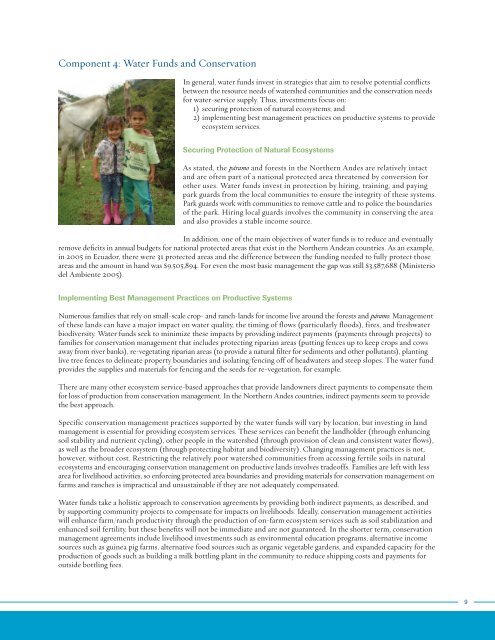Water Funds - Natural Capital Project
Water Funds - Natural Capital Project
Water Funds - Natural Capital Project
- No tags were found...
You also want an ePaper? Increase the reach of your titles
YUMPU automatically turns print PDFs into web optimized ePapers that Google loves.
Component 4: <strong>Water</strong> <strong>Funds</strong> and ConservationIn general, water funds invest in strategies that aim to resolve potential conflictsbetween the resource needs of watershed communities and the conservation needsfor water-service supply. Thus, investments focus on:1) securing protection of natural ecosystems; and2) implementing best management practices on productive systems to provideecosystem services.Securing Protection of <strong>Natural</strong> EcosystemsAs stated, the páramo and forests in the Northern Andes are relatively intactand are often part of a national protected area threatened by conversion forother uses. <strong>Water</strong> funds invest in protection by hiring, training, and payingpark guards from the local communities to ensure the integrity of these systems.Park guards work with communities to remove cattle and to police the boundariesof the park. Hiring local guards involves the community in conserving the areaand also provides a stable income source.In addition, one of the main objectives of water funds is to reduce and eventuallyremove deficits in annual budgets for national protected areas that exist in the Northern Andean countries. As an example,in 2005 in Ecuador, there were 31 protected areas and the difference between the funding needed to fully protect thoseareas and the amount in hand was $9,505,894. For even the most basic management the gap was still $3,587,688 (Ministeriodel Ambiente 2005).Implementing Best Management Practices on Productive SystemsNumerous families that rely on small-scale crop- and ranch-lands for income live around the forests and páramo. Managementof these lands can have a major impact on water quality, the timing of flows (particularly floods), fires, and freshwaterbiodiversity. <strong>Water</strong> funds seek to minimize these impacts by providing indirect payments (payments through projects) tofamilies for conservation management that includes protecting riparian areas (putting fences up to keep crops and cowsaway from river banks), re-vegetating riparian areas (to provide a natural filter for sediments and other pollutants), plantinglive tree fences to delineate property boundaries and isolating/fencing off of headwaters and steep slopes. The water fundprovides the supplies and materials for fencing and the seeds for re-vegetation, for example.There are many other ecosystem service-based approaches that provide landowners direct payments to compensate themfor loss of production from conservation management. In the Northern Andes countries, indirect payments seem to providethe best approach.Specific conservation management practices supported by the water funds will vary by location, but investing in landmanagement is essential for providing ecosystem services. These services can benefit the landholder (through enhancingsoil stability and nutrient cycling), other people in the watershed (through provision of clean and consistent water flows),as well as the broader ecosystem (through protecting habitat and biodiversity). Changing management practices is not,however, without cost. Restricting the relatively poor watershed communities from accessing fertile soils in naturalecosystems and encouraging conservation management on productive lands involves tradeoffs. Families are left with lessarea for livelihood activities, so enforcing protected area boundaries and providing materials for conservation management onfarms and ranches is impractical and unsustainable if they are not adequately compensated.<strong>Water</strong> funds take a holistic approach to conservation agreements by providing both indirect payments, as described, andby supporting community projects to compensate for impacts on livelihoods. Ideally, conservation management activitieswill enhance farm/ranch productivity through the production of on-farm ecosystem services such as soil stabilization andenhanced soil fertility, but these benefits will not be immediate and are not guaranteed. In the shorter term, conservationmanagement agreements include livelihood investments such as environmental education programs, alternative incomesources such as guinea pig farms, alternative food sources such as organic vegetable gardens, and expanded capacity for theproduction of goods such as building a milk bottling plant in the community to reduce shipping costs and payments foroutside bottling fees.9
















